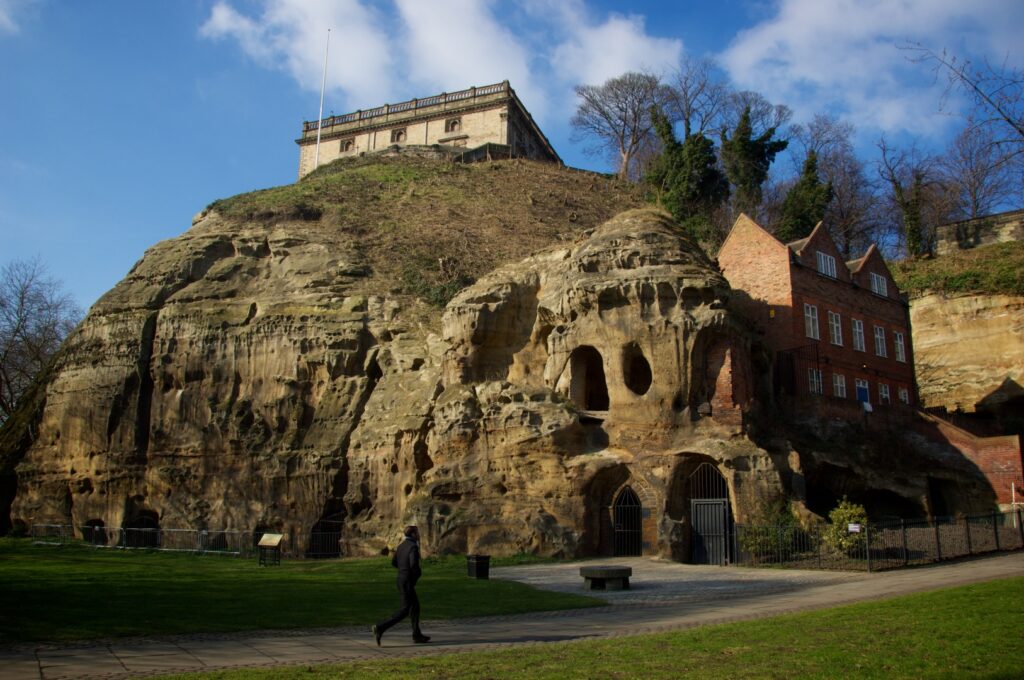The Nottingham caves have in the past been utilised for cover against the elements in the past, but many of them have only been discovered recently. The caves are still being used today for storage or as a venue for parties & concerts.
In 1330, King Edward the 3rd of England and a group of people snuck into the city’s castle & kidnapped Roger de Mortimer, who had controlled England by that point.
The man-made caves referred to in the above sentence are known as Mortimer’s Hole. They were used by insurgents during the 19th century French Revolution, but this risky plan was made possible by their network across the city.
The caves were found in Nottingham at least 1,000 years ago and were referred to as ‘Tig Guocobauc’ which when translated means “home” or “cave place”. The Welsh monk Asser who lived in the early 9th century mentions these properties.

David Strange-Walker, the Nottingham Caves Survey’s project manager, has been researching and mapping caves for over 4 years now and recently found more than he previously knew existed. This research inspired the creation of a new smartphone app that allows you to experience the city’s caves from above the ground.
Most people believe that living in the caves has been a key piece of the city’s history for centuries, and it does provide a sense of origin and belonging. Most notably during early industrial times when crowds of people would arrive looking for work.
“The result was most of the available shelter was quickly occupied” said the archaeologist. “I would put my money on slum landlords being involved because they’re just sheltering groups of people in caves, which is all fairly horrendous.”
In 1845, a law was made which made it unlawful to live in caves within Nottingham. The law basically pushed them out, making them have no choice but to search for somewhere else to live.
“It was like living in shanty towns that were built of winding tunnels and wooden floors, their passage lit by gas flares stuck above the doorways,” he said. “Hurrying figures carrying sacks of coal or bits of wood passed like phantoms through these untenanted twilight spaces.”
Drury Hill is the last remaining bit of past history in Broadmarsh. With such poor sanitation conditions, the street was considered to be a death trap; with a high chance of one of the three aforementioned diseases.
Sleep and eating conditions were getting worse in 16th century Europe, so some people chose to live in caves. They didn’t have to move out of their living room though, as they shared with family & friends.
There was a tannery near the ruins of the UK, which raised children as young as 8 for 10 hours a day with only access to buckets and little food. These children would collect human sewage from nearby cesspits, mix it with water from the stream, and use their hands to filter out particles of stone before it was thrown into vats.
Today, this location is a tourist attraction known as the Nottingham Caves. It is only a small section of the city’s underground network but it offers tours of Nottingham’s grisly cave-dwelling heritage which includes stories about murders, crimes committed by rogue honeymooners, and people trapped in caves or wells
One of the attractions’ tour guides, Andy Fowler, gave a description of conditions for children working in team-building workshops during the 1500s and how they had to live and work in foul-smelling caverns.
Skin and fat mixture might have been used as leather. One of the steps that could have been involved in their job was to combine water, lime and animal skin, meaning they would end up with hands like claws.
The plague was quite bad for them, but they were able to produce offspring despite their shorter lifespan.
A plague in Medieval times was not easy to contract. One rat found in a tannery was the only casualty of the tannery, and it hadn’t been infected yet. It helped that there weren’t many spots where rats slept so they weren’t swept up in every living thing’s breath
Visitors at the museum can only access the cellar through one small door. The hole in the ceiling is about as big as a golf ball. It is thought that the cave, which was thought to have been a method utilised by those wishing to break the law that could be could be made aware of authority by the dropping of stones through a hole in the roof, was intentionally sealed.
There is actually a difference between supporting and plotting an escape from prison. In the 19th Century, this was likely completed by the Luddite movement as popular legend has it, but the real story probably happened differently.
Bradgate Brides do not have a cave but our bridal shop is often labelled ‘magical’ by our Nottingham brides-to-be!